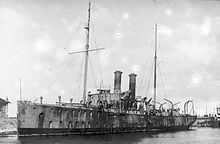SMS Panther
.jpg) SMS Panther | |
| Career (German Empire) | |
|---|---|
| Name: | SMS Panther |
| Builder: | Kaiserliche Werft, Danzig |
| Laid down: | 1900 |
| Launched: | 1 April 1901 |
| Commissioned: | 15 March 1902 |
| Decommissioned: | 31 March 1931 |
| Fate: | Sold and scrapped 1931 |
| General characteristics | |
| Class and type: | Iltis-class gunboat |
| Displacement: | 977 t (962 long tons) (designed) 1,193 t (1,174 long tons) (maximum) |
| Length: | 66.9 m (219 ft 6 in) o/a 64.1 m (210 ft 4 in) w/l |
| Beam: | 9.7 m (31 ft 10 in) |
| Draught: | 3.3 m (10 ft 10 in) |
| Propulsion: |
|
| Speed: | 13.5 knots (15.5 mph; 25.0 km/h) |
| Range: | 3,400 nmi (6,300 km) at 9 kn (10 mph; 17 km/h) |
| Complement: | 130 |
| Armament: | |
SMS Panther was one of six Iltis-class gunboats of the Kaiserliche Marine and, like its sister ships, served in Germany's overseas colonies. The ship was launched on 1 April 1901 in the Kaiserliche Werft, Danzig. It had a crew of 9 officers and 121 men.
Design
Under Kaiser Wilhem II's Weltpolitik Germany would require a series of warships to protect the country's colonies. Their design required them to be both ocean-going as well as being able to navigate in the shallower waters of estuaries and rivers.
Designs were drawn up by Schichau shipyard and the first two gunboats were Iltis and Jaguar followed by four larger vessels. Panther had several improvements including higher caliber armaments and no ramming stem.
Service history
In September 1902, after the Haitian rebel ship Crête-à-Pierrot hijacked the German steamer Markomannia and seized weapons destined for the Haitian government, Germany sent the Panther to Haiti.[2] The Panther found the rebel ship. The rebel Admiral Killick evacuated his crew and blew up the Crête-à-Pierrot, which was by then under fire from the Panther.[2] There were concerns about how the United States would view the action in the context of the Monroe Doctrine. But despite legal advice describing the sinking as "illegal and excessive", the US State Department endorsed the action. The New York Times declared that "Germany was quite within its rights in doing a little housecleaning on her own account".[2]
Some months later the Panther participated in the German naval contingent during the Venezuela Crisis of 1902-1903 and bombarded the settlement of Fort San Carlos, near Maracaibo.[3] The shallow waters that connected lake Maracaibo with the sea were passable for major ships only in the strait that separated San Carlos from the island of Zapara, yet even there it needed the help of a local pilot to avoid the sand banks and shallow waters of the passage. The battle started when the fort's gunners opened fire as the Panther was crossing the bar. The Panther returned fire, but the shallow waters limited its effectiveness. Inside the fort, two gunners (Manuel Quevedo and Carlos José Cárdenas) managed to score several hits on the Panther with their 80-millimeter Krupp gun, causing considerable damage. After half an hour of exchanging fire, the Germans retreated.
In 1905, the Panther was deployed to the Brazilian Port of Itajahy, where its crew conducted an unauthorized search, capturing a German deserter on Brazilian soil. This incident became known as the "Panther Affair" ("Caso Panther").[4][5][6][7][8]
The ship was scrapped in 1931.
Agadir Crisis

The Panther became notorious in 1911 when it was deployed to the Moroccan port of Agadir during the "Agadir Crisis" (also called the "Second Moroccan Crisis"). The Panther was supposedly sent to protect German citizens in the port. (A German sales representative, Hermann Wilberg, had been sent to Agadir on behalf of the Foreign office, but only arrived three days after the Panther.) The ship's actual mission was to apply pressure on the French, as the latter attempted to colonize Morocco, to extract territorial compensation in French Equatorial Africa. This was an example of "gunboat diplomacy". The incident contributed to the international tensions that would lead to the First World War.
See also
Notes
- ↑ http://archive.org/stream/marineboilersthe00bertuoft/marineboilersthe00bertuoft_djvu.txt| p. 465
- ↑ 2.0 2.1 2.2 Mitchell, Nancy (1999), The Danger of Dreams: German and American Imperialism in Latin America, University of North Carolina Press. pp77–78
- ↑ Mitchell (1999:101)
- ↑ Joffily, Jose (October 1988). O Caso Panther (in Portuguese). Editora Paz e Terra.
- ↑ Seyferth, Giralda (November 1994). O Incidente do Panther (Itajai, SC, 1905) (in Portuguese) 4. Rio de Janeiro: Comunicacoes do PPGAS.
- ↑ Guedes, Max Justo (2002). O Barao do Rio Branco e a Modernizacao da Defesa (PDF). Rio Branco – a America do Sul e a Modernizacao do Brasil (in Portuguese). Fundacao Alexandre de Gusmao. pp. 314–315. Retrieved 2006.
- ↑ Fauchille, Paul (1906) [1894]. Revue Generale de Droit International Public (PDF). Droit de Gens – Histoire Diplomatique – Droit Penal – Droit Fiscal – Droit Administratif (in French) 13. Paris: A. PEDONE, Libraire-Editeur. pp. 200–206. Retrieved 2006.
- ↑ Millarch, Aramis (October 1988). "A noite em que a Alemanha invadiu o porto de Itajai" (in Portuguese). Retrieved 2006.
References
- Simpson, Lloyd P. (1966). "The German-Haitian Naval Clash of 1902". Warship International (Toledo, Ohio: International Naval Research Organization) III (23): 216. ISSN 0043-0374.